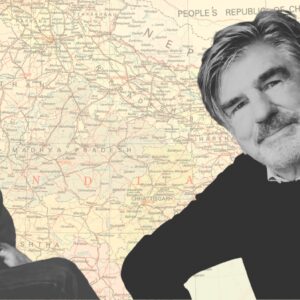
Rambling Genealogies: Nandshankar Mehta and the Forgotten History of South Asian Cosmopolitanism
Radha Vatsal on the Contemporary Echoes of Her Ancestor’s Groundbreaking 19th-Century Novel
On a sultry summer morning in 1863, in the port city of Surat on the western coast of India, while British officers still tossed and turned beneath the mosquito nets covering their beds, and a few intrepid souls chatting in Gujarati made their way to the Tapti river to bathe or wash their clothes in the shadow of shuttered shipyards, twenty-eight year old school headmaster Nandshankar Mehta climbed the stairs to the attic of his modest home, hitched up his cotton dhoti, and sat cross legged on the floor to write.
His wife later said that he barely stopped to think, barely crossed out a word as he told a tale set at the close of the 13th century, when India comprised a patchwork of warring kingdoms, and Karan, the Hindu ruler of Gujarat (now an Indian state), is about to lose his kingdom to a Muslim sultan from Delhi.
Nandshankar’s novel, Karan Ghelo (“Foolish Karan”) was published in 1866 and has never been out of print since. It is widely considered to be the first novel written in Gujarati—one of the fourteen major languages of India. The novel—historical fiction based on real events—was adapted into plays, used as a text in Gujarati-language schools, and read by British officials who wanted to study the language and learn local customs.
Nandshankar Mehta was my maternal great-great grandfather. I first read Karan Ghelo after it was translated into English in 2015 by Aban Mukherji and Tulsi Vatsal, Nandshankar’s descendant and my mother.
Localism and cosmopolitanism are not at odds—it is only when the nation-state becomes paramount that cosmopolitanism becomes suspect.
There is something unnerving about reading your ancestor’s words. I felt that whatever Nandshankar wrote, whatever views the novel expressed would reflect on me, and braced myself for awkward surprises. Thanks in part to the notion of “western-educated elites,” which is a fixture of popular and academic discourse about India, I was in thrall to an unexamined narrative: that cosmopolitanism and liberal values are fundamentally western ways of being and thinking. Inasmuch as both run deep in my family, I assumed they were the result of generations of Nandshankar’s descendants having studied abroad. But Nandshankar himself was educated in Surat—a town I barely registered growing up in Bombay, India’s commercial capital 200 miles to the south. So as I read Karan Ghelo, I was unprepared for his sense of humor, his choice of subject matter, his even-handed and non-judgmental treatment of all his characters, especially women and Muslims (Nandshankar was a Hindu). Far from being illiberal or prejudiced, as I had feared, this 19th century school headmaster felt like a wise and witty contemporary.
I followed the novel with a biography of Nandshankar, Nandshankar Jeevanchitra (“A Picture of Nandshankar’s Life”), written by Vinayak Mehta, his youngest son and my great-grandfather. Fluent in Gujarati, Farsi, English, and Sanskrit, Vinayak studied at Cambridge University and the University of Heidelberg in the early 1900s. The biography was published in 1916, eleven years after Nandshankar’s death. It was translated from Gujarati into English in 2021 by another of Nandshankar’s descendants, Radhika Jayakar Herzberger. Although I was born and raised in India, I read both the novel and the biography in English since I don’t read or understand literary Gujarati.
The biography describes life in Surat, Nandshankar’s priestly Nagar Brahmin caste, and the effects of the introduction of British education to Gujarat—the state where Surat is located. Vinayak recounts his father’s experience in Surat’s first English-language school, which was established by the British in 1842, and where Nandshankar enrolled in 1845, when he was ten. He went on to become a teacher there, and then headmaster. Yet, despite Vinayak’s assertion that secular, British education exposed Nandshankar and the people of Surat to modern, liberal ideas, it is impossible to read the biography and not come away with the impression that it was Surat’s cosmopolitan culture and the liberal mores of the Nagar brahmin community that allowed Nandshankar to be open to those ideas in the first place—and put his own spin on them.
Karan Ghelo tells the real story of the 13th century Hindu king, Karan, who covets his prime minister’s wife and abducts her. Out for revenge, the betrayed prime minister travels north and convinces Sultan Allauddin Khilji, of the mighty Turko-Afghan dynasty that rules Delhi, to invade Karan’s realm. Karan not only loses Gujarat, but his wife flees and marries the Muslim ruler, and in Nandshankar’s account, Karan’s daughter marries the sultan’s son. It is the story of the end of an era—of a Gujarati-speaking, Hindu dynasty being replaced by a Farsi- and Arabic-speaking, Islamic one. That’s a striking choice for the first-ever Gujarati novel, but it allows Nandshankar to reflect on his present moment: By the 1860s, when he writes Karan Ghelo, the region has undergone yet another regime change. The sultans and their successors have been replaced—first by the British East India Company, which ruled over Gujarat for nearly 50 years, and then, in the wake of the 1857 Indian Uprising, by the British government.
Nandshankar makes the connection between his and Karan’s times explicit in the novel’s final lines. He observes that although 550 years have passed since Karan’s death, not much has changed; neither Hindus nor Muslims are as valorous as they once were. Both, he writes, “have been subjugated by the white man…The whole of Gujarat is under British control. But by God’s grace, this province will flourish once again…”
In their Afterword, Karan Ghelo’s translators observe that Nandshankar, like other Gujarati reformers, “was convinced that whatever the drawbacks of British rule, Pax Britannia would restore Gujarat to its former glory.” I disagree. In the final lines, Nandshankar invokes God, not Queen Victoria. Though he refuses to demonize outsiders, he doesn’t put them on a pedestal either. For instance, his description of Sultan Allauddin Khilji’s brutality toward his enemies is devoid of accusations of barbarism or excessive hand-wringing. In Nandshankar’s telling, it is Khilji’s ruthlessness that makes him a powerful ruler. No further judgments are required.
The translators also tell us that the novel makes frequent use of Persian and Arabic phrases. In the biography, Vinayak defends his father’s choice, asking: “Should one pretend that Muslims never did enter Hindustan [India], and that their language, ideas and their ways have in no way influenced Gujarati speech? This kind of talk is pure illusion…In Hindustan, Hindus and Muslims will always live side by side and move together.”
This matter-of-fact acceptance of Muslims, their language and culture might seem unfathomable today. But, as Karan Ghelo illustrates, India’s history is a series of negotiations with, and adaptations to, outsiders.
Nandshankar’s portrayal of women is also unexpected. He writes that “in general” women and men have vastly different temperaments, but acknowledges that in some cases there are “men possessed of feminine qualities and women possessed of masculine ones.” He tells the story of Karan’s chief queen, Kaularani, who flees her husband’s kingdom on horseback dressed in men’s clothes. This woman, who was used to “sleeping on the softest mattresses,” now endures the heat of the summer sun, and sleeps on a bed of dried leaves or amongst tree branches.
During the course of her journey, she encounters a gang of bandits and when their chief tries to rape her, she kills him, plunging her sword into his stomach. She performs the deed “so rapidly and with such skill” that the bandit doesn’t even cry out. She then coolly stashes his body behind a chest, slips into his clothes, and rides off into the night.
When we see her next, Kaularani is absorbed in conversation with Sultan Khilji. She’s decked in jewels and sipping wine. She has become the sultan’s favorite queen. Far from condemning her infidelity, Nandshankar condones her behavior. “One should not conclude,” he writes, that her “earlier sorrow [when she left Gujarat] had been false….God in his mercy has given mankind the ability to adapt and, assisted by hope, even intense grief passes with time.” That observation, in particular, grabbed my attention. Even today, allowances made for “mankind” don’t often extend to women.
While the novel also describes women in conventional terms—as nurturing, selfless, or noble—Nandshankar never limits his female or male characters to stereotypes. When Karan’s prime minister, Madhav, is finally reunited with his abducted wife, he takes her back joyfully and without hesitation. This is in contrast to most traditional Hindu narratives, in which the husband rejects a wife who has been ‘defiled’ by another man’s attentions.
Vinayak credits English education for Nandshankar’s open-mindedness on a range of issues and although he doesn’t say so explicitly, seems to subscribe to the idea of liberalism as the worldview of “western-educated elites.” In the biography, he describes the “sea change” that occurred when the British established the first English school in Surat. Yet, his own account of Nandshankar’s Nagar brahmin community complicates this belief. Nagars—among the highest castes in the region—had been civil servants or senior officials in the courts of Hindu kings and Muslim sultans for centuries. Like Karan’s prime minister in Karan Ghelo, whom Nandshankar portrays as a Nagar, Nandshankar become an administrator for the British and later served as prime minister for the Indian princely state of Kutch. And Vinayak was the first Gujarati to pass the Indian Civil Service examinations and served as a senior administrator under the British until his death in 1940—seven years before India’s independence. Which is to say, well before the British arrived in India, generations of Nagar men had made their living adapting to new regimes and ideas, speaking multiple languages, and adjudicating between competing claims.
Women and girls occupied a relatively privileged space in Nagar society, despite the prevalence of child marriage. For instance, Nandshankar’s marriage to his wife, Nandagauri. was arranged when she was four and he was sixteen, and they married when she was ten. From a western perspective, this seems incomprehensible: A society that normalizes child marriage shouldn’t be one in which women have any agency. But these are precisely the kind of contradictions that existed in the world that Nandshankar and Vinayak inhabited and continue to be part of Indian culture.
Early on in the biography, Vinayak recounts the story of Nandshankar’s grandmother, Umiyakunvar, who was widowed in 1801. According to custom, she should have spent the first year of her widowhood in her in-laws’ home, but she couldn’t tolerate being stuck in a place where she had no friends. She was the proud daughter of a landowning clan, she was “obstinate,” and “she had tasted the freedom given to women in Olpad [her hometown].” So Umiyakunvar woke up early one morning and wrote in charcoal on her in-laws’ front door: “Do not look for me. I have gone to Olpad”—proving, Vinayak drily notes, “at the very least, that women of the time were literate.” Then, carrying her infant on her hip, she walked out.
In order to make it home, she had to cross the Tapti river, which lacked a bridge. Unwilling to wait for the ferry to arrive, she tied her son to her back and swam across. Vinayak takes pains to point out that Nandshankar knew his “spirited grandmother,” who died when he was ten.
Coming so early in the biography, Umiyakunvar’s journey reads like Nandshankar’s “origin story.” And it is. In contrast to her heroics, Vinayak tells his readers that Umiyakunvar’s husband, who died at the age of twenty-six, was a man “bestowed with an enthusiasm for wealth, rather than its reality” and “given to telling tall tales.” His and Umiyakunvar’s son, Tuljashankar—Nandshankar’s father—was an official in the customs department, “a gentle sort, unassuming, straightforward, and fond of telling jokes.” When it came time to arrange Tuljashankar’s marriage, Umiyakunvar made certain that her son was betrothed to a girl from her own, wealthier clan. This allowed him to set up home in Surat, and later, send young Nandshankar to the English school that opened there. As Vinayak recounts his family’s history, the men were feckless and the women saved the day. Despite generations of child marriage, Nandshankar grew up in a culture where women asserted themselves.
At school, Nandshankar was exposed to subjects like astronomy and English literature. Vinayak quotes Nandshankar, who says that his association with the school’s principal, a man by the name of Henry Greene, and his friend, Captain Scott, “‘attracted me to English virtues.’” Nandshankar also appreciated that Greene and Scott treated their Indian students with dignity. He says that although he and his peers were well-behaved, they “‘had no idea what the English might consider civilized behavior. Those generous men understood that many different communities other than their own might also be civilized.’”
But Nandshankar’s observation also reflects his own understanding that there isn’t a single, uniform standard for what it means to be “civilized”—the definition changes depending on where you’re from. Which is itself a radical idea.
This brings us to Surat, Nandshankar’s hometown, a port city on India’s western coast. Like Alexandria, Aden, Shanghai, and later, New York, Surat was a hub where people and ideas from all around the globe mingled and influenced each other. Vinayak describes the city’s heyday—from about the late 16th through the 17th centuries under the Moghul empire—during which Surat was known as the “Gateway to Mecca” and the “Gateway to Trade.” He says that Portuguese, Dutch, French, Austrian, Swedish, and English traders all came to Surat first, and Surati brokers and businessmen “were the first to meet foreign traders and become involved in their gains and losses.” Vinayak describes Surati traders as “stylish men,” who developed exotic tastes thanks to their foreign connections. He mentions a visiting author who “likened Surat to Venice,” and quotes from the songs that local women sang, which reflected both their sense of entitlement and awareness of the world: “‘Fetch her diamonds from the Fort at Hormuz, tiny pearls from Singapore; and only gold from Sri Lanka will do…’” In fact, Gujarat’s trade with the west dates back to imperial Rome.
We are all heirs to rambling genealogies. And the mixing of different cultures, ideas, people, and languages has always been part of the human experience.
In the 1770s, Vinayak writes, the flags of both the British and the Mughals flew over Surat. Customs changed as the British became ascendant: “Today, a man doffing his hat signifies elevated status; in those days, a young dandy donned colorful turbans in the Moghul style…to proclaim his status in society.” For the privileged classes, it seems that no matter who was in charge, only external signifiers changed.
The city’s fortunes took a downward turn by the middle of the 18th century as it relinquished its position as the pre-eminent port on India’s western coast to Bombay. Yet, its sophistication, openness to the outside world, and diversity remained. There was constant mingling between Hindus, Muslims, and Parsees (Zoroastrians), and Jains; and Suratis regularly interacted with English, Irish and Scotsmen who came to the region.
The students who attended Surat’s English-language school spoke Gujarati, Farsi, Arabic. It is likely that several also studied Sanskrit. And they didn’t meekly accept whatever ideas were on offer, but picked and chose those that appealed to them. Vinayak notes, for instance, that apart from John Milton’s Paradise Lost, Nandshankar favored authors who were atheists. And resistance to Christian teachings in Surat’s English schools was so strong that Principal Greene campaigned against proselytization in an effort to avoid losing students. (This resulted in the more “narrow-minded elements” of English society declaring that Greene was in the clutches of a “Native Delilah.”)
In Surat, western education mixed with local cosmopolitanism to produce a bold new generation of thinkers, writers and reformers. These included Nandshankar’s contemporaries and friends, all of whom feature prominently in Vinayak’s account. There’s the poet Narmadashankar, who didn’t “give a hoot about his reputation” and invited a destitute widow to live with him in his home; Mahipatram, who opposed idolatry and broke caste to travel to Europe; Navalram, a critic who “wielded words like a delicate scalpel, not a cruel axe.” They, and others like them, ensured their sons, daughters and wives received a westernized, secular education; they thought for themselves; and spoke their minds.
This, in turn, led a generation of Indians who were active in the country’s independence movement and in its post-Independence life. Women like Nandshankar’s granddaughters, Hansa Mehta, a champion of women’s rights who was involved in drafting independent India’s constitution; and her cousin, Vinayak’s daughter, Pupul Jayakar, who was instrumental in reviving India’s handloom and handicraft industries and served as the cultural advisor to two of India’s prime ministers, Indira and Rajiv Gandhi.
As one of only two women on the UN Commission on Human Rights in the late 1940s, Hansa called for the language of the Universal Declaration on Human Rights to be changed from “All men are created equal,” to “All human beings are created equal.” She held her ground despite pushback both from male delegates and Eleanor Roosevelt, an icon of American feminism and the chair of the Commission. Recent scholarship is bringing to light not just Hansa’s contributions to our contemporary understanding of human rights, but also that of other women from the global south.
Nandshankar leaves a complex legacy because his open-minded cosmopolitanism is at odds with both our current era of simplistic nationalism and rote anti-colonial discourse. His outlook on the world is neither anti-Muslim nor anti-British. Referring to the 1857 Indian Uprising—in the aftermath of which the British government took over rule of India from the British East India Company—Nandshankar says in the biography: “’If truth be told, we [the Nagar brahmin community of Surat] were enamored of English rule even though the rulers were foreign. There was a thousand times more happiness among people under English rule than under the corrupt Moghuls or the plundering Marathas [another Hindu dynasty].’”
He explains that the ultimate defeat of the Indians who rose up against the British “’left a deep impression on our minds; we realized that India was not one united entity…The ideal of nationhood will not be nourished as long as we are a country with multiple ideologies, without a common language, one in which there are continuing clashes between religious groups.’”
Whether or not one agrees, Nandshankar’s views aren’t a sign of his westernization, but of how ineradicably Indian he is—Indian understood as a person who is both deeply rooted in their local community and clan and open to outside influences. Localism and cosmopolitanism are not at odds—it is only when the nation-state becomes paramount that cosmopolitanism becomes suspect. Being receptive to Islamic and British ideas didn’t make Nandshankar any less of a Nagar Brahmin or a Gujarati.
As someone who spent her childhood in India, speaks English as her first language, and shares much of what we would now characterize as Nandshankar’s liberal outlook, I have long felt pressure to think of myself as not “really” Indian or as a “western-educated elite.” But that is just buying into a worn-out stereotype of Indians as tradition-bound and backward. I am who I am as the result of a long process of adaptation to and negotiation with outside influences that began in 13th century Gujarat, when a Muslim sultan conquered a Hindu king.
We are all heirs to rambling genealogies. And the mixing of different cultures, ideas, people, and languages has always been part of the human experience. To pretend that there was ever some glorious moment when that was not the case, is, as Vinayak puts it, “pure illusion.”
Featured image: Rahul Bhadane, used under CC BY-SA 4.0
Radha Vatsal
Radha Vatsal is the author of No. 10 Doyers Street. Her writing has appeared in The New York Times, The Atlantic, The Los Angeles Review of Books, and elsewhere. She received her Ph.D. in Film History from Duke University, and is a 2024-25 fellow at the CUNY Writers’ Institute. She lives in New York City.












